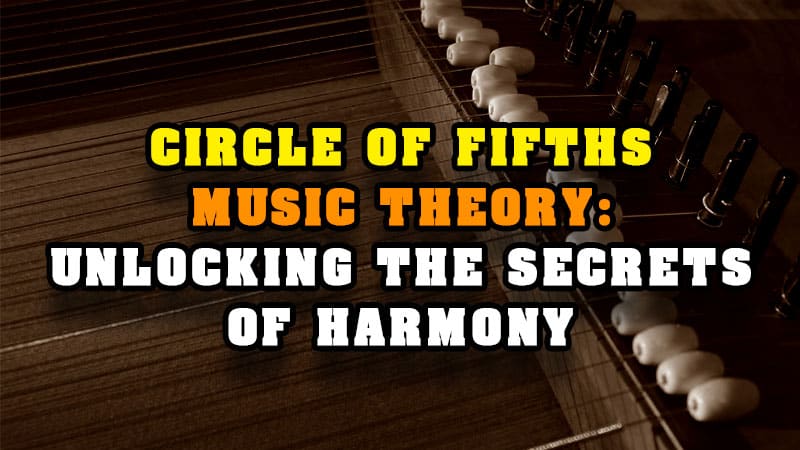Imagine you’re spinning a big wheel that helps unlock the mysteries of Western music theory—that’s the circle of fifths. It’s a visual tool that can feel like a secret code to make sense of keys, chords, and scales. This circular cheat sheet maps out the relationship between the 12 tones in the chromatic scale, arranging them a perfect fifth apart. As you go clockwise, each note is five steps away from the last, which is why it’s called the circle of fifths.
As you dive into music theory, you’ll find the circle of fifths isn’t just a fancy ornament—it’s incredibly practical. You’ll see how it illustrates the number of sharps or flats in a key signature, making it easier for you to recognize key changes and predict chord progressions that will sound harmonious. This translates to almost any instrument you might play, helping you to understand which chords naturally fit together and even compose your own music.
Essentially, the circle of fifths is your roadmap through the landscape of Western music. Whether you’re strumming a guitar, tickling the ivories, or writing the next big hit, this tool helps you navigate through notes and keys with an understanding of how they’re all connected. So think of it as your music theory compass, guiding you through the harmony and patterns that make music sound so good.
Understanding the Circle of Fifths
The Circle of Fifths isn’t just a fancy concept; it’s a practical music theory tool that ties together notes, keys, and chords in a coherent system, making sense of how they interact.
Components of the Circle
In your journey into music theory, imagine the Circle of Fifths as a clock with 12 positions. Each ‘hour’ represents a musical note along with its corresponding major and minor key. The Circle starts with C at the top (noon position), with no sharps or flats. As you move clockwise, each subsequent note is a perfect 5th higher, thus the name. Each jump adds a sharp while going counterclockwise, you add flats. This circle helps you visualize and remember the key signatures for both major and minor keys.
Navigating Major and Minor Keys
Every major key on the Circle of Fifths has a relatively minor key. They share the same key signature but start at different notes. To find a relative minor of any major key, count three steps counterclockwise. For example, if you’re at C major, the relative minor is A minor. They connect like friends with a secret handshake; knowing one gives you a hint about the other.
Key Signatures and Their Relationships
Understanding key signatures is crucial when you’re grappling with the Circle of Fifths. Here’s a brief rundown:
- Major Keys: 0 sharps – C; 1 sharp – G; 2 sharps – D; 3 sharps – A; 4 sharps – E; 5 sharps – B; 6 sharps – F#; 7 sharps – C#.
- Minor Keys: 0 flats – A; 1 flat – E; 2 flats – B; 3 flats – F#; 4 flats – C#; 5 flats – G#; 6 flats – D#; 7 flats – A#.
Within the circle, neighboring keys are closely related and share many common tones. For instance, G major and C major are side by side, differing by just one sharp. This relation also translates to chord progressions, where moving to a chord a fifth away feels natural and harmonically pleasing.
Whether you’re looking to compose, transpose, or understand intervals and chords, the Circle of Fifths is your go-to map for navigating through the complexities of music theory. It’s an essential tool that, once mastered, reveals a whole new world of harmonic understanding.
Practical Applications in Music
The Circle of Fifths isn’t just a chart to hang on the wall; it’s a dynamic tool that you’ll use to craft harmonies, navigate key changes, and inject creativity into your songwriting arsenal.
Chord Progressions and Harmony
You can depend on the Circle of Fifths to lay out chord progressions that naturally sound pleasing. It visually illustrates how to move from chord to chord by following the circle:
- I – IV – V Progression: For a major scale, this progression moves clockwise, hitting the next two segments.
- II – V – I Progression: Essential in jazz, starts at the ii (minor), to V (dominant), and resolves to I (tonic).
Using this guide, you’ll see why some harmonies feel like they’re made for each other — they align perfectly with the circle’s natural flow.
Modulation and Tonal Center Shifts
Modulation, or shifting the tonal center of a piece, can add a refreshing twist to your music. The Circle of Fifths shows you which keys are neighbors, making modulations smooth and musically logical. To modulate:
- Move Clockwise: To raise the tension with a subtle shift to a sharper key.
- Move Counterclockwise: For a more relaxed vibe, transitioning to a key with fewer sharps or more flats.
Tight shifts between similar keys keep your listeners grounded as they experience the journey through different moods.
Creative Use in Composition and Songwriting
As a songwriter, you’re always hunting for fresh ideas, and the Circle of Fifths is ripe with them. You can:
- Use tritones and dominant chords for dramatic effect.
- Explore borrowed chords from adjacent keys to add color.
- Experiment by writing songs that leap across the circle, defying conventional wisdom for a unique sound.
Connecting with the Circle of Fifths unlocks a sandbox of musical possibilities, so dive in—let it fuel your creative fires.
Conclusion
When tackling the circle of fifths, you’re dealing with a straightforward concept that’s quite a powerhouse in music theory. Picture it as your musical roadmap; it provides you with a visual representation of the relationship between keys in Western music.
- Key Signatures: You’ll quickly spot the number of sharps or flats just by glancing at your position within the circle.
- Chord Progressions: Crafting chord progressions becomes a more intuitive process. Adjacent keys are harmonically compatible, which means they’ll blend smoothly in your compositions.
- Transposition: Thinking about changing the key of a piece? The circle helps you shift with ease, maintaining the musical relationships.
- Improvisation: If you’re the type to riff or improvise, the circle is like your cheat sheet for which notes will hit the right emotional tone.
Remember, the circle is your friend. It’s not an ancient relic that’s out of reach but a tool that’s there to be used. Dive in, play around with it, and you’ll find that what once seemed complex is now a simple grid that helps you unlock a richer understanding of music. So go on, give it a spin!



